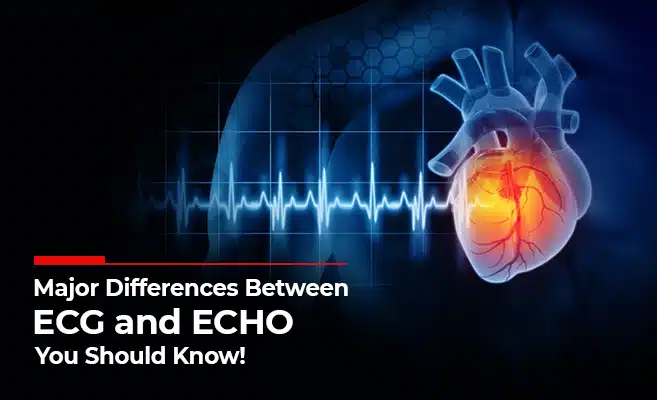Difference Between ECG And ECHO?

ECG vs EKG is a different abbreviation for a similar test. An electrocardiogram is a process to measure how electricity functions in a person’s heart. It is also referred to as an electrocardiograph. ECG is a painless process, and it is attached to one’s body to check impulses.
The electrical impulses help to push the blood around the entire body. It runs through a person’s heart as it beats. The electrodes are attached to one’s body to detect the electrical balance.
Echocardiography uses ultrasound waves which create a heart picture. During the process, no radiation is produced. A doctor checks the size of the chambers, the functioning of the heart, the direction of blood flow, and cardiac muscles.
Echocardiography is done to check the heart’s health, whether they would go through a stroke or heart attack. Furthermore, you will get to know the main difference in ECHO and ECG.
Purpose of the Process
ECG or EKG is done when they find an issue with the heart rhythm of any person. It helps determine the sinoatrial sound, the atrioventricular node, the nerve conduction pathway in the person’s heart, rate and rhythm of the heart.
The ECG or EKG is recommended by a doctor when they feel any blocked blood vessels or feeling any kind of chest pain, detect any heart attack, find an issue with the heart’s rhythm, have heart failure, and have an irregular heartbeat.
An echocardiogram is an ultrasound procedure where doctors identify a person’s heart problems. An echocardiogram is used to determine the pumping of the blood, detect the blockage of muscles in the heart, locate blood clots or tumours if any, diagnose heart disease, assess the pressure in the heart, and monitor how the heart responds to different heart treatments. A doctor will recommend only when he sees shortness of breath, high or low blood pressure, leg swelling, irregular heartbeat, or any sound heart between heartbeats.
Procedure
A person does not have to prepare himself before getting an ECG done. During the process, the patient has to lie down on the bed the person has to unbutton their clothes covering the area of their chest after that the doctor will attach electrodes to the arms, legs, and chest, the electrodes measure the magnitude and direction of the electrical impulses, the computer records the heart activity connected to electrodes. Lastly, the electrodes get removed, and the person can relax.
In an Echocardiogram, the sonographer spreads get on the device, then presses the device (transducer) lightly against the skin, the soundwaves echoes get recorded from the heart, and then the computer converts the echoes into the moving images of the monitor.
Types
ECG is of two types:
Exercise EKG: A person goes through this exercise when they are performing exercises. The technician can make it difficult for you for any changes in the heart activity. The technician will stop the process when he finds any irregular activity occurring. He would examine you during the entire process.
Holter Monitor: An EKG that a person wears for a certain period. The device can be hung around the waist as a belt or around the neck. The technician will attach the electrodes to the skin connected to the recording machine.
The different types of echocardiograms are:
Transthoracic: The most common echocardiogram in which the device is placed on the patient’s chest. The gel application makes it easier to detect soundwaves and helps them to travel faster.
Transesophageal: It uses a thin transducer attached to the long tube at the end. The person will have to swallow the tube that connects the mouth and stomach. This helps to get a closer picture of the organ to detect the problem easily.
Doppler Ultrasound: It is used to check the flow of blood. It is done by generating sound waves at particular frequencies, determining how they bounce and return to the device. It helps to detect any problems with valves and see the associated problems.
Interpreting The Results of ECHO Vs ECG
The ECG denotes irregular heart rate, irregular heart rhythm, abnormalities in the shape of the heart, imbalances in the electrolyte, high blood pressure, and heart attack. The ECG occurs when an issue with the heart arises or getting treatment for something else where the heart reports are important. The treatments can be done when any irregularities are found.
After the ECHO is done, the reports appear, and the doctor will see all the images and compare if there are any damaged heart muscle or tissue, thin or thick ventricle walls, abnormal chamber size, poorly functioning valves, decreased pumping strength, blood clots, etc. The ECHO is done to consider these facts and check if there are any irregularities. If something is not normal, then proper treatment has to be done.
Conclusion
The advancement of technology makes these treatments easy with the help of ECG and ECHO. The echo and ECG might sound familiar as they are done for the treatment of the heart, but there is a huge difference between them. The heart is an important aspect of our body, and it is important we take care of it properly. Technology advancement saves the lives of many by going through these tests. The irregularities are recorded by getting these tests done, which helps the doctor treat them better.

 Book An Appointment
Book An Appointment Virtual Consultation
Virtual Consultation




